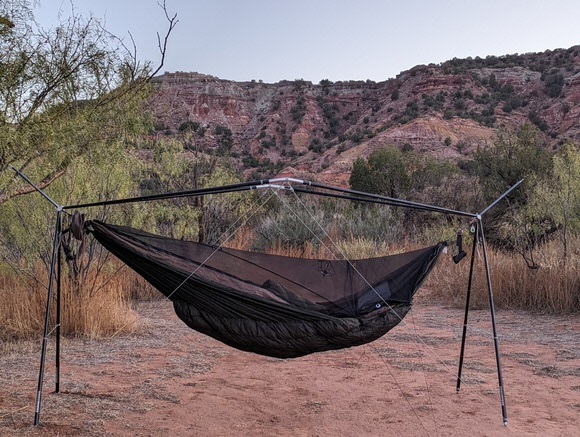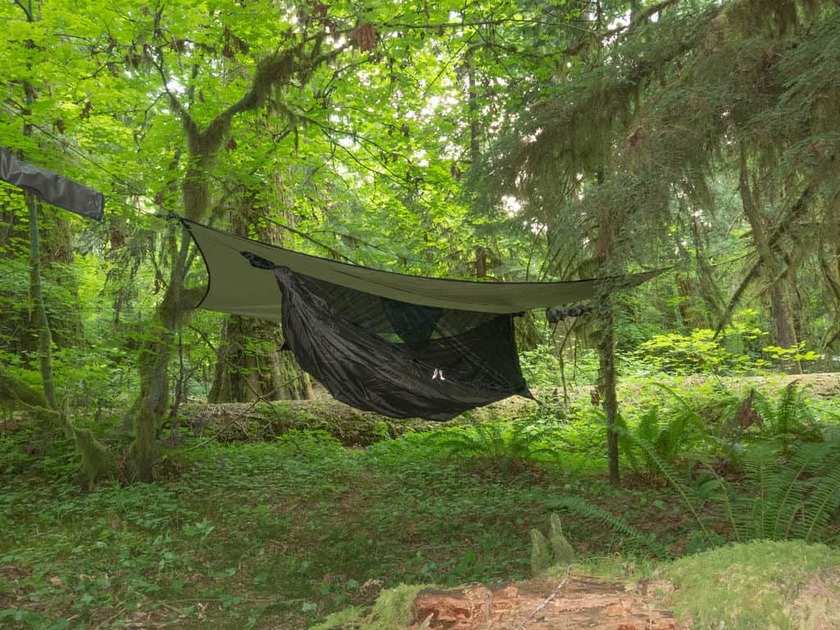Camping in the wilderness offers an opportunity to connect with nature, escape from the hustle and bustle of daily life, and explore the great outdoors. One of the most comfortable and lightweight options for wilderness camping is a hammock. However, finding and choosing the perfect camp spot for a hammock requires careful consideration and planning. This essay will guide you through the process of identifying the ideal location for your hammock camping experience.
Understanding Hammock Camping
Hammock camping is a unique form of camping that involves suspending a hammock between two sturdy points, typically trees, and sleeping above the ground. This method of camping is becoming increasingly popular among outdoor enthusiasts due to its numerous advantages and unique experiences. However, it also requires a different set of considerations compared to traditional tent camping.
Advantages of Hammock Camping
One of the primary advantages of hammock camping is its minimal impact on the environment. Unlike tents, which require a flat, cleared area to set up, hammocks leave no footprint and do not disturb the ground beneath them. This makes hammock camping a more sustainable and environmentally friendly option.
Another advantage of hammock camping is the comfort it offers. Many people find that sleeping in a hammock provides a more restful sleep as it allows for a natural, curved sleeping position which can be more comfortable than sleeping on the hard ground. Furthermore, hammocks provide excellent ventilation, keeping you cooler on warm nights and allowing you to enjoy the fresh air.
Hammock camping can also significantly reduce the weight of your backpack. Hammocks are typically lighter than tents, and you won't need to carry a sleeping pad or an air mattress. This can make a significant difference, especially on longer hikes or backpacking trips where every ounce counts.
Unique Considerations for Hammock Camping
While hammock camping offers numerous benefits, it also requires a unique set of considerations. The most obvious one is the need for two sturdy suspension points. In most cases, these will be trees, but they could also be posts, rocks, a hammock stand (if weight is not an issue,) or even vehicles in a pinch. The suspension points need to be strong enough to support your weight and ideally spaced about 10 to 15 feet apart.
Another consideration is the weather. While hammocks are great for warm, clear nights, they can be challenging in cold or wet weather. Without the insulation provided by a tent, you can get cold quickly, especially as the wind can circulate underneath you. To combat this, many hammock campers use underquilts for insulation and tarps for protection against rain.
Finally, hammock camping requires careful site selection. You need to consider not only the availability of suitable suspension points but also factors like wind exposure, potential for flooding, and proximity to water sources or trails. It's also essential to check whether hammock camping is allowed in the area, as some parks and wilderness areas have restrictions to protect trees and other natural features.
Understanding hammock camping is crucial before you venture out. While it offers unique advantages like less environmental impact, comfortable sleep, and a lighter backpack, it also requires careful planning and consideration. With the right preparation, hammock camping can be a rewarding and enjoyable outdoor experience.
Location, Location, Location
The location of your hammock camp spot is a crucial factor that can significantly impact your camping experience. The perfect location will depend on the type of wilderness you are exploring, and it requires careful consideration of several factors.
Forested Areas
In forested areas, trees are the most common suspension points for hammocks. However, not all trees are suitable. They need to be sturdy enough to support your weight and the tension of the hammock. Look for healthy, living trees with a diameter of at least 6 inches. Avoid trees that show signs of disease or damage, as they may not be strong enough to support a hammock.
The spacing between the trees is another important factor. The ideal distance is typically about 10 to 15 feet. If the trees are too close together, the hammock will be too curved, making it uncomfortable to lie in. If the trees are too far apart, the hammock will be too flat or may not even reach.
Desert or Mountainous Areas
In desert or mountainous areas where trees may be scarce, finding suitable suspension points for a hammock can be more challenging. In these environments, you may need to get creative and consider alternative suspension points.
Rock formations can be a good option, but they must be sturdy and stable. Look for large rocks or boulders that are firmly grounded. You can use climbing slings or ropes to secure your hammock, but make sure that they are not causing damage or erosion to the rock.
Sturdy shrubs or small trees can also be used, but they need to be strong enough to support your weight. Always test the strength of potential suspension points before setting up your hammock to avoid accidents.
In some cases, you may need to use a combination of natural features and man-made structures, such as vehicles or trail posts, to set up your hammock. Always ensure that your setup is secure and stable before settling in for the night.
Using a Hammock Stand for Camping
While hammocks are traditionally hung between two trees or sturdy points, this isn't always possible, especially in environments where such natural supports are scarce or non-existent. In such cases, a hammock stand can be an excellent solution. This is particularly true for car camping or overlanding, where the additional weight and bulk of a hammock stand are less of a concern.

My Warbonnet Blackbird XLC hung on the YOBOgear Cricket stand (my preferred hammock stand when car camping/overlanding) in Palo Duro Canyon SP (TX.) No rain in the forecast, so I opted for a 'no-tarp' deployment.
Advantages of Using a Hammock Stand
A hammock stand offers several advantages. Firstly, it provides flexibility in terms of where you can set up your hammock. You're no longer limited to finding the perfect pair of trees; you can set up your hammock anywhere you have flat ground.
Secondly, using a hammock stand can be more environmentally friendly. There's no need to worry about damaging trees with straps or ropes, making it a great option for areas where tree protection is a priority.
Lastly, a hammock stand can offer more stability and security than hanging a hammock between two trees. You don't need to worry about the trees being strong enough to support your weight or the hammock straps slipping.
Considerations When Using a Hammock Stand
While a hammock stand offers many benefits, there are also some considerations to keep in mind. Firstly, hammock stands are heavier and bulkier than hammocks alone. This makes them less suitable for backpacking or hiking trips where weight and space are at a premium. However, for car camping or overlanding, this is less of a concern.
Secondly, not all hammock stands are created equal. Some are designed for specific types of hammocks, while others are more versatile. When choosing a hammock stand, make sure it's compatible with your hammock and can support your weight.
Lastly, while a hammock stand provides more location flexibility, you still need a relatively flat and clear area to set it up. It's also still important to consider the weather and environmental conditions. For example, in windy conditions, a hammock on a stand may be more exposed than one hung between trees.
Using a hammock stand for camping, particularly for car camping or overlanding, can offer a convenient and flexible way to enjoy hammock camping. With careful consideration of the type of stand and the camping environment, a hammock stand can provide a comfortable and enjoyable camping experience.
The location of your hammock camp spot is a vital factor that requires careful consideration and planning. Whether you're in a lush forest or a rugged desert, finding the perfect spot will ensure a safe and comfortable hammock camping experience.
Environmental Considerations
The environment plays a significant role when choosing a hammock camp spot. It's not just about finding two sturdy points to hang your hammock, but also about considering the overall environment and how it might impact your camping experience.
Obstacle-Free Area
Firstly, look for a location that's relatively flat and free of obstacles like rocks, roots, and uneven ground. While you'll be sleeping above the ground in a hammock, you still need a clear area to move around, cook, and perform other camping activities. An obstacle-free area also provides a safer environment in case you fall out of the hammock.
Wind Direction
Wind direction is another important environmental factor to consider. A spot that's shielded from the wind will provide a more comfortable camping experience, especially in colder weather. Wind can significantly lower the temperature and make your hammock sway, which can be uncomfortable and even dangerous in strong gusts. Look for natural windbreaks like hills, dense vegetation, or large rocks.
Sun Exposure
Consider the amount of sun exposure your chosen spot will receive. While a sunny spot might be pleasant during the day, it can become uncomfortably hot in the afternoon. A location with some shade will provide protection from the sun and keep the temperature in your hammock more comfortable. However, be careful of spots under large trees, as falling branches can pose a risk.
Rainwater Runoff
If there's a chance of rain, consider potential rainwater runoff. Avoid setting up your hammock in a low-lying area or a spot where water could pool. Not only can this lead to a wet and uncomfortable night, but it can also pose a risk in heavy rain when flash flooding can occur. Look for higher ground and consider the slope of the terrain to ensure water will flow away from your camp spot.
Environmental considerations are crucial when choosing a hammock camp spot. By taking into account factors like obstacles, wind direction, sun exposure, and potential rainwater runoff, you can select a spot that is not only suitable for hanging a hammock but also provides a safe and comfortable camping environment.
Safety and Regulations
When planning for a hammock camping trip, safety and adherence to regulations should always be paramount. These considerations not only ensure your wellbeing but also help preserve the natural environment for future visitors.
Safety Considerations
Safety starts with the selection of your hammock camp spot. Avoid areas near cliff edges or loose rocks, which can pose a risk of falls or landslides. Similarly, steer clear of dead or diseased trees that could potentially fall. When choosing trees to suspend your hammock, ensure they are healthy and robust.
Wildlife is another important safety consideration. While encountering wildlife can be an exciting part of the wilderness experience, it's crucial to maintain a safe distance. Avoid camping near animal trails or feeding areas, which can attract wildlife. Be aware of signs of wildlife such as tracks, droppings, or chewed vegetation, and store food securely to avoid attracting animals to your campsite.
Regulatory Considerations
Before setting up your hammock, always check the regulations of the area you're camping in. Different parks or wilderness areas may have different rules regarding hammock camping. Some areas may prohibit hammocks altogether, while others may allow them but have restrictions on where you can set them up.
Many parks require the use of tree-friendly straps to hang hammocks. These straps are designed to distribute weight evenly and prevent damage to the tree bark. Using ropes or thin cords can cut into the tree bark and cause damage, so it's important to use the appropriate equipment.
In some cases, you may need to obtain a permit to camp in certain areas. Always check with the local park or forest service for the most accurate and up-to-date information.
Safety and regulations are critical aspects of hammock camping that should not be overlooked. By prioritizing safety and adhering to local regulations, you can ensure a positive hammock camping experience that respects and preserves the natural environment.
Conclusion
Finding and choosing the perfect wilderness camp spot for a hammock requires careful consideration of the location, environment, safety, and local regulations. By taking the time to plan and select the right spot, you can ensure a comfortable, safe, and enjoyable hammock camping experience. Whether you're gazing at the stars from a desert landscape or waking up to the sounds of a forest, hammock camping offers a unique way to connect with nature and explore the great outdoors.


















